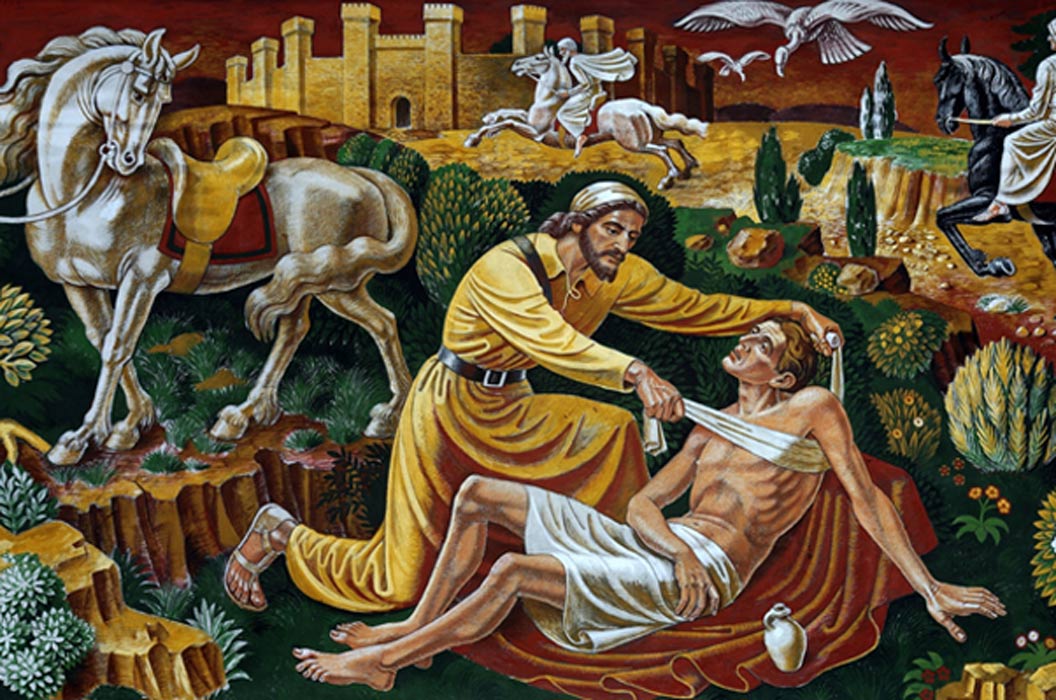The Powerful Politics Behind the Parable of the Good Samaritan
Today, the term “Good Samaritan” is often used to refer to any person who does a selfless good deed for a stranger or someone who is not part of their normal ingroup. It is also referenced in the name of many humanitarian organizations such as Samaritan’s Purse and the Flying Samaritans. The term “Good Samaritan,” which is recognizable to most westerners and other people living in historically Christian cultures, comes from a passage in the Bible where Jesus is talking about what it means to be a neighbor.
The Parable of the Good Samaritan
The context of the parable is set up in Luke 10:25-29 where Jewish religious leaders are challenging Jesus and one of them asks him a question, hoping to find a question Jesus can’t answer to show that he is little match for the real spiritual experts in Judaea. Rather than giving them a direct answer, Jesus answers with a parable:
“Behold, a certain lawyer stood up and tested him, saying, “Teacher, what shall I do to inherit eternal life?”
He said to him, “What is written in the law? How do you read it?”
He answered, “You shall love the Lord your God with all your heart, with all your soul, with all your strength, and with all your mind; and your neighbor as yourself.”
He said to him, “You have answered correctly. Do this, and you will live.”
But he, desiring to justify himself, asked Jesus, “Who is my neighbor?”
Jesus answered, “A certain man was going down from Jerusalem to Jericho, and he fell among robbers, who both stripped him and beat him, and departed, leaving him half dead. By chance a certain priest was going down that way. When he saw him, he passed by on the other side. In the same way a Levite also, when he came to the place, and saw him, passed by on the other side. But a certain Samaritan, as he traveled, came where he was. When he saw him, he was moved with compassion, came to him, and bound up his wounds, pouring on oil and wine. He set him on his own animal, and brought him to an inn, and took care of him. On the next day, when he departed, he took out two denarii, and gave them to the host, and said to him, ‘Take care of him. Whatever you spend beyond that, I will repay you when I return.’ Now which of these three do you think seemed to be a neighbor to him who fell among the robbers?”
He said, “He who showed mercy on him.”
Then Jesus said to him, “Go and do likewise.”” (Luke 10:25-37, WEB)

The Good Samaritan brought the man to an inn and took care of him. (Vert / Public Domain)
Who Were the Samaritans?
Volumes have been written on the theological and ethical meaning of this passage. Many interpreters would suggest that Jesus is saying that to be a neighbor to someone is to show kindness to them and that anyone, even a Samaritan, can be a neighbor. But what is so remarkable about a Samaritan being a neighbor?
The Samaritans are an ethnic and religious group that still exists today which follows an ancient form of Judaism. They have their own copy of the Torah which has slight differences from the Jewish Torah. The Samaritans believe that only the Torah is scripture. They do not believe the Prophets or the Writings to be authoritative. Another distinction is that they believe that the true temple to Yahweh should be built on Mount Gerizim instead of at Jerusalem.
- Walking the Waves: Celestial Puns Resolve the Conflicting Accounts of Jesus’ Sea-Walk Miracle
- The Surprising Truth About Fasting for Lent
- Did Jesus Have a Wife? New Tests on Ancient Coptic Papyrus May Give Answers

Samaritans on Mount Gerizim during Passover. (Ras67 / CC BY-SA 3.0)
Today, the two monotheistic sects exist alongside each other tranquilly in the Levant. During the time of Jesus, however, there was a bitter rivalry between the Jews and the Samaritans. The Jews considered the Samaritans to be heretics and the Samaritans rejected the legitimacy of the Jewish priesthood in Jerusalem as well as a significant part of the Jewish scriptures.
Origin of the Samaritans
In 587 BC, the kingdom of Judah was conquered by the Babylonian Empire and the Jewish elites, including members of the priesthood, were taken to Babylon to be educated in Babylonian culture. After the Babylonian Empire was conquered by Cyrus the King of Persia in 539 BC, the Jews were allowed to return to their native land.
The Jews returning from exile settled in Jerusalem. Over time, the Jerusalemite priesthood gained influence. Some Israelites living in the north, however, did not agree with the views of the priests in Jerusalem. This led to a schism. Those in the north made their own version of the Torah which was very similar with slight differences. One of the main differences was that the holy place where the temple to Yahweh was to be built was at Mount Gerizim near Shechem rather than Jerusalem.
This religious division eventually led to political division. After Palestine was conquered by Alexander the Great in the 330s BC, it came under Macedonian rule. Alexander the Great allowed the Samaritans to build a temple to Yahweh on Mount Gerizim in 332 BC. After his death in 323 BC, Palestine eventually went to the Seleucid dynasty. The Samaritans and the Jews reacted in very different ways to the influence of Greek culture.
In 168 BC, the Seleucid ruler Antiochus IV Epiphanes attempted to consecrate the Jerusalem temple to Zeus and the Jews responded by revolting against Seleucid rule. This revolt was spearheaded by Judas Maccabees and led to the establishment of the Hasmonean dynasty in Judah.

Battle of Judas Maccabeus – Maccabeus led the Jewish revolt against the Seleucid ruler Antiochus IV Epiphanes while the Samaritans accepted the new ruler. (National Library of the Netherlands / Public Domain)
The Samaritans, on the other hand, were more comfortable with Seleucid rule and did less to resist the intrusion of paganism. Many pagan groups lived in Samaria and their capital city, also called Samaria. In addition to tolerating paganism, the Samaritans also tended to side with the enemies of the Jews which further aggravated relations between the two monotheistic sects.
This political tension reached its height when, under the Hasmonean ruler and high priest John Hyrcanus I, the Judahites invaded Samaria and destroyed the temple atop Mount Gerizim around 120 BC.
Judah eventually succumbed to Roman rule in 63 BC and the Jews lost their control over Samaria. Despite this, there was still a lot of bitterness between Samaritans and Jews by the time of Jesus.

Stone entrance and wall of ruined synagogue in the ancient city Samaria, home of the Samaritans. (slavapolo / Adobe)
Jesus and the Samaritans
In light of this history, it is understandable that the last thing any respectable Jewish rabbi would have done, at the time, would be to use a Samaritan as a good example in a parable about morals, just as a Samaritan teacher would have been unlikely to use a Jew as a good example. It also helps the reader understand the point that Jesus is making in the passage. By using a Samaritan, Jesus is saying that fulfilling the great commandment to love others is not based on ethnic or other group divisions.
A good neighbor shows kindness regardless of a person’s ethnic affiliation or ingroup. A good neighbor does this even if the other person is part of a group that happens to be among his or her worst enemies.
By including a priest and a Levite, a member of the Israelite tribe that contained the priestly lineage, Jesus also makes the point that those we would expect to show kindness may also fail to do so. Both the priest and the Levite would have been expected in Jewish culture to help their fellow Jew. Jesus is saying we should treat everyone, both those within our ingroup and outside of our ingroup as a neighbor, just like the Good Samaritan.
Top image: The Good Samaritan. Source: Howgill / Adobe.
By Caleb Strom
References
Bible History Online. The Samaritans. [Online] Available at: https://www.bible-history.com/Samaritans/SAMARITANSBrief_History.htm
Gospel of Luke, 10:25-37. World English Bible. [Online] Available at: https://ebible.org/web/LUK01.htm
Gottheil, Richard, and Meyer Kyserling. 1906. Hyrcanus, John (Johanan) I. Jewish Encyclopedia. [Online] Available at: http://www.jewishencyclopedia.com/articles/7972-hyrcanus-john-johanan-i
Jewish Virtual Library. N.D. Ancient Jewish History: Roman Rule. [Online] Available at: https://www.jewishvirtuallibrary.org/roman-rule-63bce-313ce
Lendering, Jona. 2017. Samaritans. [Online] Available at: https://www.livius.org/articles/people/samaritans/



















